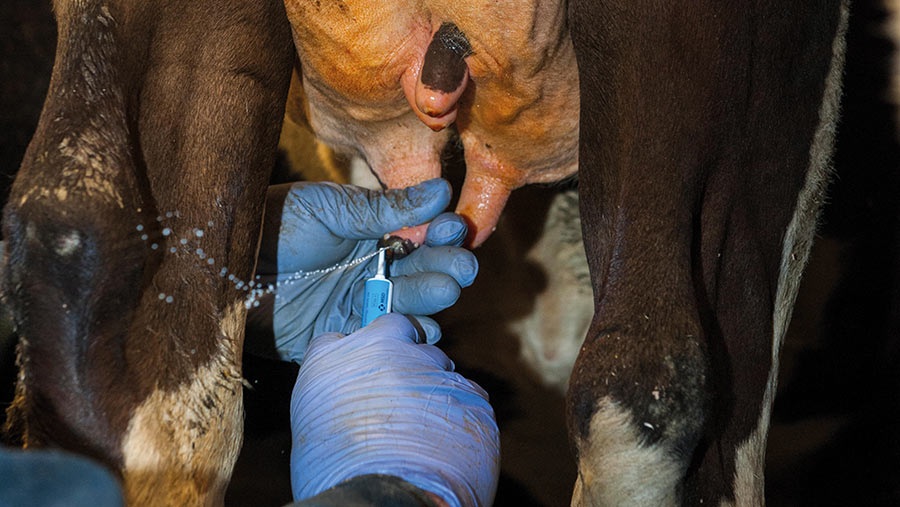Guidance on mastitis recovery rates helps aid treatment plans
 © Wayne Hutchinson/Alamy Stock Photo
© Wayne Hutchinson/Alamy Stock Photo A new model developed by Quality Milk Management Services (QMMS) could help farmers better understand the probability of individual cows recovering from a case of clinical mastitis, therefore guiding better treatment decisions.
This could also help protect against antimicrobial resistance, according to Ian Glover, QMMS clinical associate.
Mr Glover explained that while antimicrobial therapy can improve both bacteriological and clinical cure rates, there may be times when it is not the best approach.
“Cure rates of cases of clinical mastitis are governed by three elements – cow, pathogen and treatment factors.
“With regards to treatment, if a cow has a low probability of cure – regardless of pathogen or treatment protocol – antimicrobial therapy may be justifiably withheld under circumstances where reduction of antimicrobial use is desirable.”
See also: 3 steps to reduce mastitis risk in dairy cows at housing
Mr Glover has been looking specifically at cow factors and working to develop a model that generates a probability of curability based on these factors (see “Factors affecting treatment success”).
Factors affecting treatment success |
|
|
|
Outcome |
|
Age of parity |
Increasing age is associated with poorer cure rates (bacteriological, cytological) and a greater probability of mastitis recurrence |
|
Stage of lactation |
Inconsistent |
|
Season |
Improved bacteriological cure rates in winter |
|
Previous subclinical mastitis |
|
|
Previous clinical mastitis |
Inconsistent |
|
Number of quarters affected |
Inconsistent |
|
Quart position (front or back) |
Back quarters have poorer bacteriological and cytological cure rates |
|
Clinical signs |
|
The model combines these factors to generate a probability percentage, though the upper and lower limit of what is deemed “worthy” for antibiotics treatment should be a decision made by farmers and their vets, added Mr Glover.
“We know from previous research that there are several cow factors that implicate curability.”
Mr Glover said preliminary work suggested the model is highly predictive and has the potential for use in real time.
Where cows have a low probability of cure, pain relief should still be given, as well as considering whether culling is an option for persistently sick cows.
The next stage of the project is to roll this out to farm software to enable farmers to make better decisions about mastitis treatment.
Example of predictions of cure probability from the model
Cow 1
- Second-lactation cow
- 150 days in-milk
- One front quarter affected
- First case this lactation
- No cases of clinical mastitis in the previous lactation
- Latest somatic cell counts: 8,000/28,000/10,000 cells/ml
- Cure probability = 61%
Cow 2
- Sixth-lactation cow
- 140 days in-milk
- Two back quarters affected
- Second case this lactation
- Two cases of clinical mastitis in previous lactation
- Latest somatic cell counts: 3,774,000/2,345,000/2,410,000 cells/ml
- Cure probability = 2%
Ian Glover, QMMS, was speaking at the British Mastitis Conference on 10 November.
